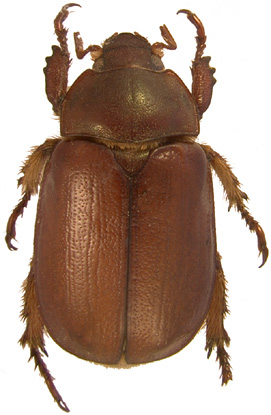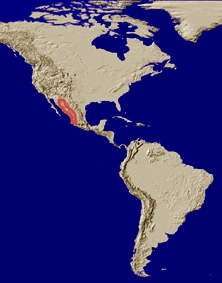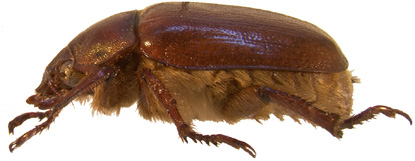 |
|||||||
|
|||||||
Parabyrsopolis Ohaus, 1915
syn. Cotalpa (Parabyrsopolis) Ohaus, 1915
syn. Parareoda Casey, 1915
Parabyrsopolis chihuahuae
photo by Matthew R. Moore
distribution of Parabyrsopolis
Parabyrsopolis chihuahuae
photo by Matthew R. Moore
|
||
| Rutelinae Taxa Map | ||
| Rutelini Taxa Map | ||
| Rutelinae Key | ||
| Rutelini Key | ||
| Areodina Key | ||
| Areodina Gallery |
Diagnosis: Parabyrsopolis is distinguished from the other Rutelinae and Areodina by the following combination of characters: (1) clypeus sinuate laterally, converging apically toward a truncate or rounded apex, (2) mentum notched apically, (3) parameres subquadrate apically, and (4) the absence of strong metallic green coloration. Males separated from females by presence of one enlarged, split claw on the protarsus and usually on meso- and metatarsi (Jameson 1990).
Distribution: Parabyrsopolis occurs from the southern montane region of Arizona in the United States to the Transverse Volcanic Belt near Mexico City, Mexico (Jameson 1990).
Taxonomy: Ohaus originally described Parabrysopolis as a subgenus of Cotalpa. Parabyrsopolis was also considered a junior synonym of Cotalpa (Blackwelder 1944), Paracotalpa (Arnett 1968), and Byrsopolis (Bates 1888).
Revision or Synopsis:
Jameson, Mary Liz. 1990. Revision, phylogeny and biogeography of the genera Parabyrsopolis Ohaus and Viridimicus, new genus (Coleoptera: Scarabaeidae: Rutelinae). Coleopterists Bulletin 44(4): 377-422.
Composition: The genus Parabyrsopolis contains one species: P. chihuahuae (Bates, 1888).
Biological Data (from Jameson 1990): Parabyrsopolis chihuahuae can be collected at lights at night. This species is observed flying from dusk until approximately 10:00 PM, and also during rain showers. Parabyrsopolis chihuahuae is primarily collected in pine-oak forests with other characteristic vegetation being Crategus and Pyrus (Rosaceae), Arbutus (Ericaceae), Platanus (Platanaceae), and Liquidambar (Hamamelidaceae).
References:
Arnett, R. H., Jr. 1968. The beetles of the United States (A manual for identification). American Entomological Institute., Ann Arbor, Michigan. 1,112 pp.
Bates, H.W. 1888. Pectinicornia and Lamellicornia. In: Biologia Centrali Americana. Insecta, Coleoptera, Vol. 2, Part 2: 1-432. Godman and Salvin (editors).
Blackwelder, R. E. 1944. Checklist of the Coleopterous insects of Mexico, Central America, the West Indies and South America. Part 2. Bulletin of the United States National Museum 185:189-341.
Jameson, Mary Liz. 1990. Revision, phylogeny and biogeography of the genera Parabyrsopolis Ohaus and Viridimicus, new genus (Coleoptera: Scarabaeidae: Rutelinae). Coleopterists Bulletin 44(4): 377-422.
|
||||
|
|


